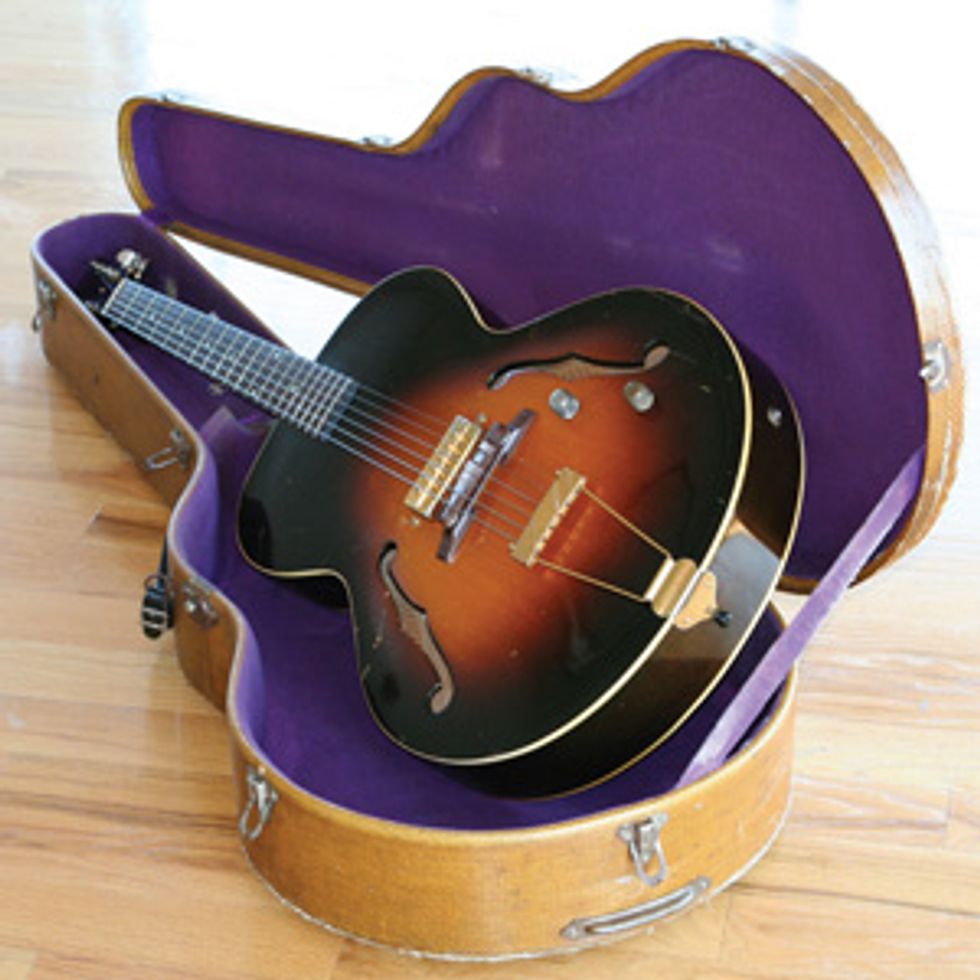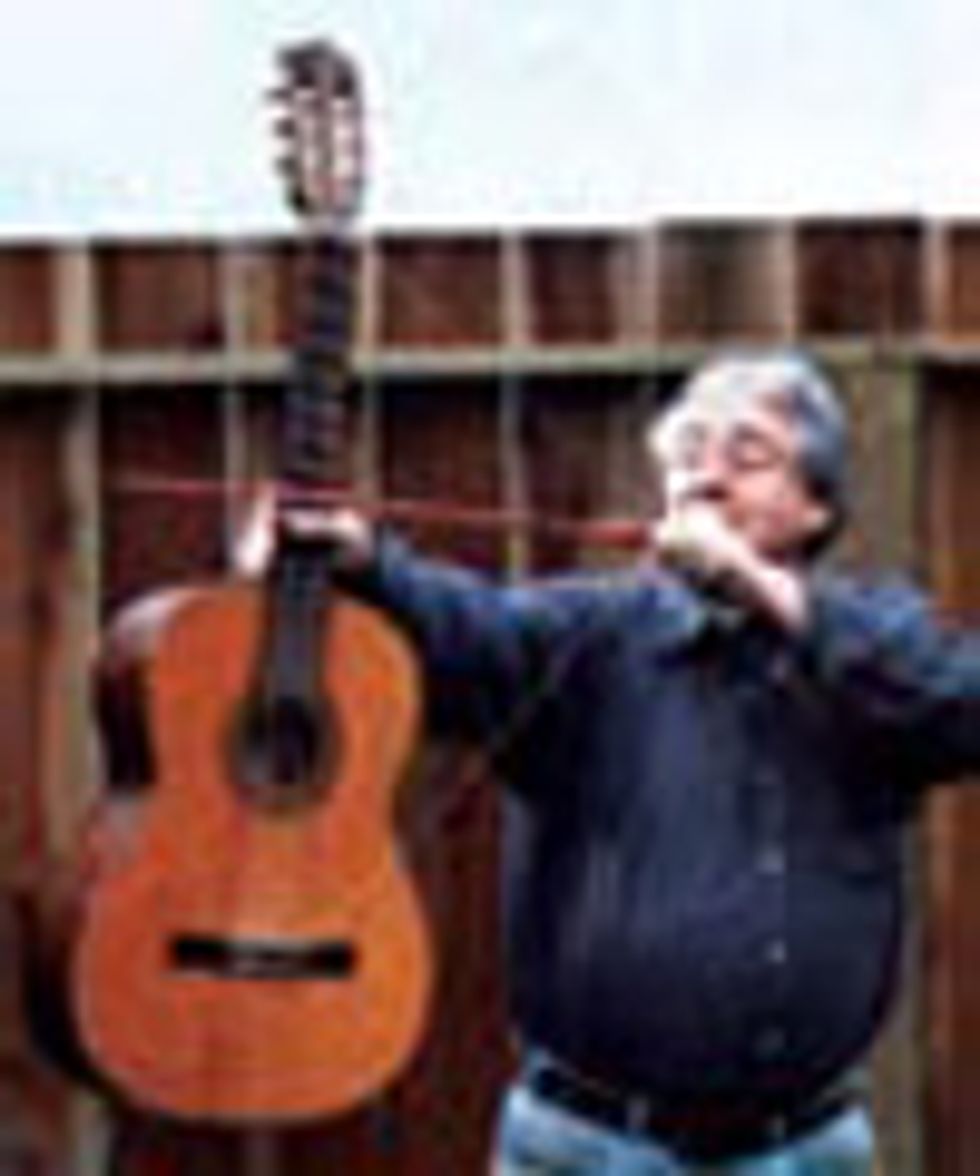
When you encounter an old acoustic guitar that sounds magical—like this 1941 Gibson ES-150—it’s tempting to speculate why. Is it due to vintage construction techniques? Decades of string vibration? Or could werewood actually play a role? Photo by Andy Ellis
Luthiers will generally agree that the acoustic guitar’s soundboard is the soul of the instrument. And they will choose a soundboard’s wood with care by considering such factors as species, grain count, color, age, provenance, grain evenness and orientation, weight, and stiffness. Popular choices for topwoods have traditionally included Sitka spruce, Engelmann spruce, Western red cedar, Italian alpine spruce, fir, redwood, pine, German spruce, red spruce, Adirondack spruce, sinker redwood, sinker spruce, and—with steelstring guitars—even koa and mahogany. With all the choices available, there is an endless debate about which topwood is “best” and how to properly use it.
I’ve been making guitars for a long time, so I too participate in this debate. My approach to the selection of the topwood relies on a favorable stiffness-toweight ratio—not so much on the grain’s evenness, count, color, etc. To me, the wood’s weight is critical and half the formula. I’ve sorted through many thousands of topwood sets in the last 40-plus years, and the range of their densities has never failed to impress itself on me.
The same has also been true of the many piles of spruce and cedar planks I’ve sorted through to made selections from. I’ve handled planks so heavy that they seemed fresh-felled and still full of water. And they’d be next to planks that were so light, you could sneeze and they’d practically blow off the pile. But these are woods of comparable size that had been kiln-dried together, so the moisture content would have been the same. I assumed this disparity was all normal and natural, until I learned about a European tradition of forestry based on the practice of cutting down woods at specific phases of the moon. This practice of wood felling is built on many centuries of empirical experience and observation, and it yields woods of consistently different density, durability, and working properties.
Wood that is felled in accordance with lunar cycles is referred to as “full-moon wood,” though somehow, I’m always tempted to think of it as werewood. Whatever one wants to call it, the fact is that our modern traditions of cutting lumber—which are not at all based on cutting woods selectively, in limited quantities, or for specific uses— have paid no attention to this practice. Our enterprises will cut day and night until the acreage has been clear-cut and the wood taken away by industrial containers, before moving on to the next acreage.
The back story on full-moon wood is quite interesting. Since before the start of the 1st millennium AD, foresters have noticed that the woods they cut yielded different working properties and durability as a direct function of where in the lunar cycle the woods were felled. Woods of any one species cut during the new moon, the full moon, or the waning moon, have consistently and predictably produced different results. Therefore, a number of especially advantageous uses for timber—including guitar tops—have been correlated with specific felling dates. These woods for soundboards are available to luthiers and can be found through a simple search by using the keywords “full moon wood.”
Some readers might be thinking that all this lore is sheer poppycock. Nonetheless, there are three points to consider that are hard to ignore. First, as already mentioned, the body of empirically collected wood-felling wisdom is very old. It applies to a range of practical wood uses as diverse as house construction, roof shingles, wooden chimneys (well, they had them in the old days), barrels for storing liquids, boxes for storing foodstuffs, firewood, plows, transportation of felled woods via river floatation, and of course, soundboards for musical instruments. In each case, woods felled at the appropriate phase of the lunar cycle may last longer, wear better, are more stable, are harder/stiffer or softer/more pliable, or are more fire-resistant or burn more easily—as their intended use requires. This information is articulately set out in a searchable article titled Lunar Rhythms in Forestry Traditions – Lunar-Correlated Phenomena in Tree Biology and Wood Properties, written by Swiss forestry expert Ernst Zürcher.
The knowledge achieved through centuries of hands-on forestry practices has necessarily and predictably resulted in a body of oral tradition, peasant wisdom, and folklore. But there does exist a significant body of historical writing and record keeping in which lunar rhythms (as well as the cycles of the seasons) are mentioned as having an influence on the growth, structures, characteristics, and properties of plants. One of the earliest examples is from the Roman writer Pliny, who had suggestions about the cutting of plants and further advice for farmers regarding picking fruit for the market versus fruit for their own stores—all with respect to different phases of the moon. For the market, fruit picked just before or at the full moon would weigh more and be more profitable to sell. But for the larder and pantry, fruit picked during the new moon would contain less water and therefore last longer.
While Pliny and some of the other historical sources are indeed European, it has been noted that the general rules for felling woods in Europe are very similar across the other continents. Whether in the European alpine regions, the Near East, Africa, India, Ceylon, Brazil, or Guyana, these traditions all seem to be based on independent (but matching) observations. It’s reasonable to believe that in the past, people had more time and more peace and quiet to observe how things work. Indeed, such knowledge would have been vital to them. We moderns are too caught up with television dramas, the rising price of gasoline, and the latest bodice-ripping revelations that emerge from Washington, Rome, Moscow, Damascus, or Beijing to notice how things grow.
 Ervin Somogyi has been a professional luthier since the early 1970s and is one of the world’s most
respected acoustic-guitar builders and
rosette designers. To learn more about
Somogyi, his instruments, or his rosette and
inlay artwork, visit esomogyi.com.
Ervin Somogyi has been a professional luthier since the early 1970s and is one of the world’s most
respected acoustic-guitar builders and
rosette designers. To learn more about
Somogyi, his instruments, or his rosette and
inlay artwork, visit esomogyi.com.
















